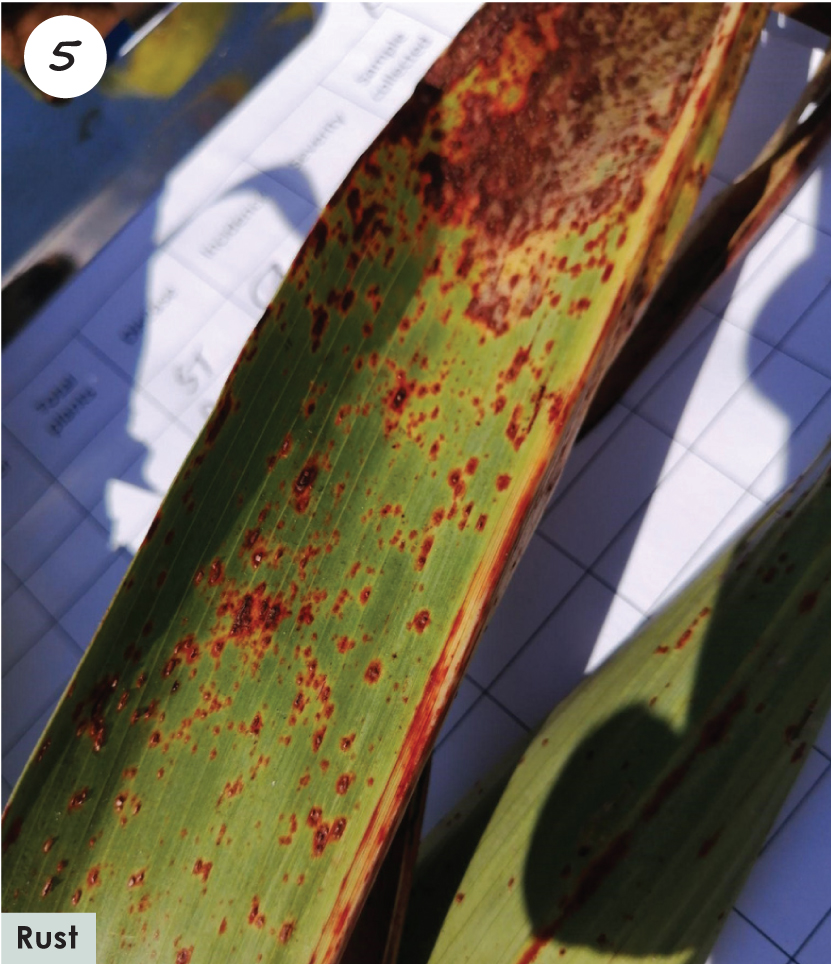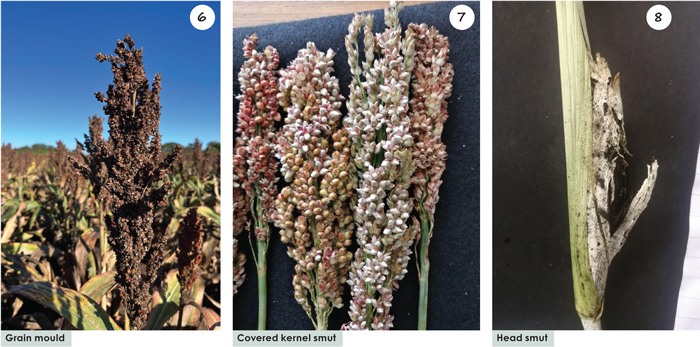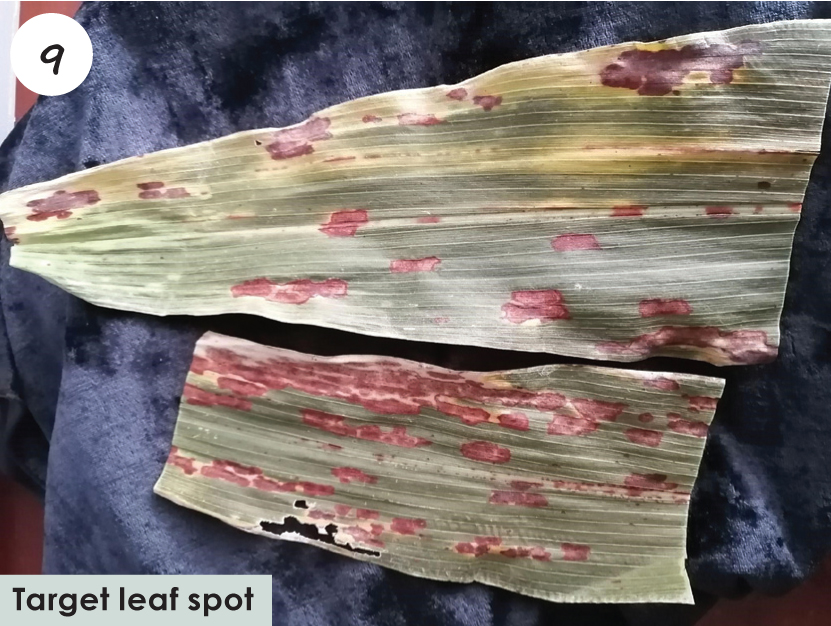
Plant Sciences, University of the Free State

Dr Lisa Rothmann,
Plant Sciences, University of the Free State
Sorghum, like any other crop, is susceptible to numerous pathogens that detrimentally impact yield and quality, affecting everything from the root to the panicle, i.e., root rot, lodging, and grain mould. Foliar diseases compromise the crop by affecting the photosynthetic capacity, hindering successful grain filling and ultimately reducing yield potential.
Head diseases diminish sorghum’s cosmetic appeal and result in mycotoxin accumulation in the grain. Mycotoxins are caused by fungal contamination of grain – in field and post harvest – and pose a risk to humans and livestock who consume contaminated grain. Furthermore, some head diseases can destroy sorghum flowers and heads by replacing plant floral structures with fungal spores, preventing the crop from bearing grain.
Cultivars face susceptibility to economically impactful diseases, exacerbated by challenges arising from climate change and the adoption of new high-yielding cultivars. Fungal diseases pose a consistent threat, often those that manifest just before or during the reproductive stages of development critical for meeting optimal yield. In areas characterised by humid, tropical, and subtropical climates, leaf diseases and grain mould play a substantial role in causing declines in grain production.
Understanding potential disease threats by determining the causal organism and extent of disease (disease intensity) is vital in ensuring optimal yields and achieving greater food safety. Disease intensity can be measured as incidence (number of plants infected) and severity (the degree of tissue affected). Greater disease intensity is driven by interacting factors such as susceptible cultivars, planting dates and growth stages favourable for pathogen establishment, conducive weather (varying across seasons and geographic areas) and different production strategies.
The epidemiology group of the Plant Pathology Division at the University of the Free State (UFS) has embarked on updating the status of current diseases causing constraints in sorghum production. The research aims to identify diseases, quantify the extent thereof, and offer practical advice to producers to mitigate disease risks. The research is supported by the Sorghum Trust and the National Research Foundation: Thuthuka Grant (TTK220323450).
During the 2022/2023 season, a survey of foliar and panicle diseases from 25 fields across five provinces (Limpopo, Mpumalanga, KwaZulu-Natal, Free State and North West) was conducted. The surveyed fields were primarily planted with different improved cultivars by commercial producers and landraces by smallholder producers.
Disease diagnosis was initiated through distinguishing symptoms and signs, sampling and measuring the incidence of diseases across environments. A total of ten diseases were observed and documented across all surveyed provinces: anthracnose; leaf blight; sooty stripe; oval leaf spot; target leaf spot; rust; zonate leaf spot; grain mould; covered kernel smut and head smut (photos 1 to 9, respectively). The most frequently identified diseases were leaf blight, anthracnose, grain mould and sooty stripe. Three fields in Limpopo exhibited a severe epidemic of grain mould, which is caused by a complex of fungal pathogens: Alternaria, Aspergillus, Curvularia, Colletotrichum, Fusarium and Phoma spp. A majority of these fungi are known to contaminate grain with mycotoxins, which, when consumed in high concentrations, are associated with cancers, immunological disorders, impaired growth and reproductive afflictions.



 During the March/April 2023 survey, 22 fields were in various stages – flowering, soft dough, or hard dough – except for the three fields where harvesting was already underway. Researchers suspect the flowering period of grain mould epidemic fields aligned with the January and February summer rainfall and high temperatures, creating conditions conducive to the occurrence of problematic disease. Leaf diseases were observed at lower incidences and severity and did not cause noticeable yield reductions. However, producers should always be on the lookout for conducive weather periods and symptoms to opt for early intervention.
During the March/April 2023 survey, 22 fields were in various stages – flowering, soft dough, or hard dough – except for the three fields where harvesting was already underway. Researchers suspect the flowering period of grain mould epidemic fields aligned with the January and February summer rainfall and high temperatures, creating conditions conducive to the occurrence of problematic disease. Leaf diseases were observed at lower incidences and severity and did not cause noticeable yield reductions. However, producers should always be on the lookout for conducive weather periods and symptoms to opt for early intervention.
 Azoxystrobin is registered for anthracnose and grey leaf spot control. Additionally, azoxystrobin + difenoconazole is registered on sorghum for sorghum leaf spot, leaf blight and rust (Puccinia sorghi). Read more about disease management by clicking on the QR code.
Azoxystrobin is registered for anthracnose and grey leaf spot control. Additionally, azoxystrobin + difenoconazole is registered on sorghum for sorghum leaf spot, leaf blight and rust (Puccinia sorghi). Read more about disease management by clicking on the QR code.
To understand the needs of producers and management decision-making, the research group also launched producer interviews. Commercial production systems planted range from 100 ha to ~3 000 ha of sorghum hybrids. In contrast, small-scale producers each plant ~1 ha, preferring landraces, intercropped with other crops such as boontjies/uChokwane (tepary bean), maize, and millet. Apart from the impact of diseases on yield and grain quality, South African sorghum producers expressed great concerns about bird attacks (red-billed quelea and wild doves) and fall armyworm infestations.
The research group will conduct another round of field surveys for the 2023/2024 season in March and April. Should producers be interested in participating, please contact Dr Lisa Rothmann at 079 270 9681 or Coetzee@ufs.ac.za or Thabiso Masisi at 081 769 8081 or 078 373 6390 (WhatsApp) or Masisi.tv@gmail.com
Reference list
- Craven, M. 2016. A look at Exserohilum leaf blight of sorghum. Accessed date 2023 December 20 < https://www.grainsa.co.za/a-look-at-exserohilum-leaf-blight-of-sorghum>
- McLaren, NW & Rothmann, LA. 2019. Management of sorghum diseases. Accessed date 2023 December 20 < https://www.grainsa.co.za/management-of-sorghum-diseases >
- Ncube, E, Nkoko, D & Rothmann, LA. 2020. Trial Results, SA Graan/Grain, October, pp 57-59.
- Nkoko, D & Flett, B. Sorghum diseases to look out for in new season. Accessed date 2023 December 20 < https://sagrainmag.co.za/2022/09/06/sorghum-diseases-to-look-out-for-in-new-season/ >





























